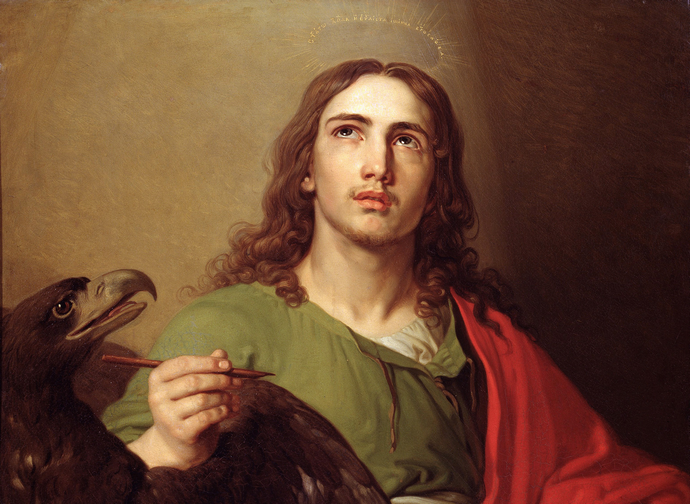St. John the Evangelist
He has been depicted with an eagle as his symbol because he contemplated the immensity of the divine Word and outlined it in his writings like no other before.

It is hard to find someone who has entered the mystery of God made man as deeply as John the Evangelist (c. 10 - c. 104), "that disciple whom Jesus loved", the youngest of the Twelve and the one who lived longest, presented in the Christian tradition as the theologian par excellence. Over the centuries he has been depicted with an eagle as his symbol because he, who at the Last Supper had laid his head on the breast of the Lord to console him and to ask who would betray Him, contemplated the immensity of the divine Word and outlined it in his writings like no other before.
John is the author of the fourth and final Gospel, the deepest theologically, whose prologue is a hymn to the divinity of Christ, the Word made flesh. He also wrote three canonical letters addressed to the early Christians, warning them against sin and the spirit of the Antichrist, who rejects the Father and the Son and "comes, indeed is already in the world". Besides, John is the author of the final book in the Bible, the Apocalypse, or Book of Revelation, the most prophetic in the New Testament, and one full of references to Old Testament prophecies. In it John shares his visions on the great combat at the end of time: the grandiose sign of the woman clothed with the sun (Ap. 12:1) will precede the triumph of Christ and of those who have persevered in His name by renouncing the seductions of Satan; they will thus obtain the eternal reward of living in the heavenly Jerusalem.
John was a contemplative with an ardent character, as suggested by the Aramaic nickname that Jesus gave to him and his brother James: Boanèrghes, "sons of thunder". Before they met the Lord and left everything to follow him, the two sons of Zebedee were fishermen in partnership with Peter and Andrew. Together with Andrew, in fact, John had been a disciple of the Baptist until the day when the latter, seeing Jesus pass by, called their attention by exclaiming: "Here is the Lamb of God!" Hearing this, the two started to follow Jesus, who turned to them and asked, "What are you looking for?" After that question, aimed right at the heart of every man's life, they spent that day with the Master they had just met; this event affectd their lives to such an extent that John, writing decades later, considered it appropriate to not only recount the meeting but also remember the time: "It was about the tenth hour", that is, four in the afternoon.
John is among the most intimate of the apostles (together with James and Peter), who witnessed to the greatest mysteries of Jesus' life, such as the resurrection of Jairus' daughter, the Transfiguration on Mount Tabor, the prayer in Gethsemane. On the day of the Resurrection, he and Peter were the first apostles, informed by a distraught Mary of Magdala, to run to the empty tomb; John "ran faster" and arrived before Peter, but entered after him: finding the bandages on the ground and the cloth that had covered Jesus' face somewhere apart "he saw and believed". As if to dispel all doubts about the Lord's will to found the Church on Peter, already made clear in the synoptic gospels (especially Matthew's), it is the beloved disciple, after Peter had been martyred, and now himself an old man, to report the dialogue between Christ and his vicar, when the latter, as if once and for all wanting to make up for his threefold denial, replied with a threefold declaration of love to the Risen Jesus, who responded three times: "Feed my sheep".
Before that moment we had found John beside Mary at the foot of the cross, at the solemn moment when Jesus had entrusted him to his own Mother ("Woman, here is your son!") and his Mother to him ("Here is your mother!") who" took her into his home." The beloved apostle, himself a virgin, together with the Blessed Virgin "full of grace", by virtue of a predilection which was to continue after the end of Jesus' earthly mission and extended to all mankind, was entrusted to Mary's spiritual motherhood.
After Pentecost and the events narrated in the Acts of the Apostles, where he is often named together with Peter in the most important phases of the newborn Church, John preached in Anatolia, particularly at Ephesus. Here, in the last century, archaeological research carried out following the revelations of Blessed Anna Catharina Emmerich, discovered the humble house where the apostle lived with Mary. And here John – the longest-living and only apostle without the title of martyr – died at a very great age after a temporary exile on the island of Patmos (following Domitian's persecution), where he wrote the Apocalypse, the last book, in which Christ says of himself: "I am the Alpha and the Omega".
Patron of: artists, good friends, Catholic writers, theologians, printers, widows




